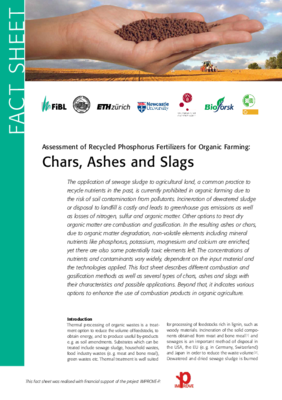Phosphorus is one essential element for plants, which can neither be produced synthetically nor substituted by any other element. Long term phosphorus management is one of the most important management challenges in organic farming, as high soluble P fertilizers derived from fossil sources are not allowed and do not contribute to the basic ideas of closing nutrient cycles. Incineration presents interesting options for the recycling of valuable elements, especially P.
According to present regulation (EC) No 889/2008 only ashes obtained from combustion or incineration of chemically untreated wood are allowed as fertilizer in organic farming. Ashes containing any other feedstock are not allowed for use, excluding most urban recycling P sources. Permission to use such fertilizers in organic farming in the EU may contribute to better nutrient cycling between rural and urban areas, reduce problems of declining phosphorus concentrations in some organic farming systems and could also contribute to the development of practical methods for processing sewage.
The use of phosphorus fertilizers derived from sewage sludge processed with various thermal treatments comprises promising options to recycle up to 90 % of P from the urban food chain back to the land by relatively sophisticated procedures, most of them leading to a significant reduction of organic pollutants including pharmaceuticals. The trade-offs between potentially toxic element concentrations and beneficial elements may be more favorable for treated sewage products than for natural phosphate rocks, bio-waste composts or in some cases even animal manure. However, all thermal processes reduce the plant P availability and lead to significant losses of nitrogen and sulfur, and the degradation of the organic matter that could potentially improve soil quality, downgrading the material from a fertilizer value perspective.
Further information
Contact
Links
- shop.fibl.org: Fact sheet "Chars, Ashes and Slags. Assessment of Alternative Phosphorus Fertilizers for Organic Farming"
- shop.fibl.org: Fact sheet "Assessment of Alternative Phosphorus Fertilizers for Organic Farming: Sewage Precipitation Products"
- shop.fibl.org: Fact sheet "Assessment of Alternative Phosphorus Fertilizers for Organic Farming: Meat and Bone Meal"
- shop.fibl.org: Fact sheet "Assessment of Alternative Phosphorus Fertilizers for Organic Farming: Compost and Digestates from Urban Organic Wastes"
- improve-p.uni-hohenheim.de: Information on the IMPROVE-P project





